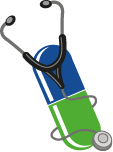Key messages: Health burden of antibiotic resistance
These key messages present the latest data and the current situation regarding antibiotic resistance.
Download

Key messages: Health burden of antibiotic resistance 2022 - EN - [PDF-233.21 KB]
- ECDC estimates that every year, throughout the European Union, Iceland and Norway, more than 35 000 people die from antibiotic-resistant infections - an estimate that has increased in recent years. The health burden of antibiotic-resistant infections is comparable to that of influenza, tuberculosis and HIV/AIDS combined.
- Overall, between 2016 and 2020, there were significantly increasing trends in the estimated number of infections and attributable deaths for almost all bacterium–antibiotic resistance combinations in the EU/EEA, although there was a small decrease from 2019 to 2020, during the first year of the COVID-19 pandemic.
- Over 70% of the health impact of antibiotic-resistant infections is directly linked to healthcare-associated infections. This could be minimised through adequate infection prevention and control measures, as well as antibiotic stewardship in healthcare settings.
- The largest burden of disease was caused by third-generation cephalosporin-resistant Escherichia coli, followed by meticillin-resistant Staphylococcus aureus (MRSA) and third-generation cephalosporin-resistant Klebsiella pneumoniae.
- Resistance to antibiotics that are used for last-line treatment of bacterial infections, such as the carbapenems, has the greatest impact on health. The number of deaths caused by infections with the carbapenem-resistant bacteria increased between 2016 and 2020. For carbapenem-resistant Klebsiella pneumoniae and Acinetobacter spp., which are a common cause of healthcare-associated infections, the number of attributable deaths increased by approximately 50% between 2016 and 2020.
- Between 2016 and 2020, the greatest increases in the number of cases and antimicrobial resistance (AMR) percentages for Acinetobacter spp. were reported by countries that already had high AMR percentages of reported Acinetobacter spp. cases prior to 2020.
- Acinetobacter spp. in healthcare is especially problematic since it can persist in the healthcare environment for long periods and, once established, is notoriously difficult to eradicate.
- In 2018, the Organisation for Economic Co-operation and Development (OECD) estimated that each year, infections due to bacteria resistant to antibiotics cost the healthcare systems of EU/EEA countries EUR 1.1 billion.
- There is a clear correlation between the frequency of antibiotic use in a population (e.g. in primary care) and corresponding levels of antimicrobial resistance in bacteria responsible for infections in the same population. In other words, the more antibiotics consumed in a country, the higher the resistance percentages are in this country.
- In addition, implementation of and compliance with infection prevention and control measures is inversely correlated with levels of antimicrobial resistance, particularly in hospitals and other healthcare settings. This indicates that the more attention that is paid to infection prevention and control in a country, the lower the resistance percentages will be.
- During the period 2012–2021, a statistically significant decrease in antibiotic consumption was observed in the EU/EEA, both in the community (primary care settings) and in hospitals. Statistically significant increasing trends were only observed for one country (Bulgaria).
- It is possible that factors related to the COVID-19 pandemic had an impact on community antibiotic consumption in the EU/EEA as of 2020 (e.g. changes in disease transmission, healthcare-seeking behaviour, prescription practices and lower incidence of non-COVID-19 related respiratory tract infections attributed to non-pharmaceutical interventions). Nevertheless, the increase in the ratio of ‘broad’- to ‘narrow’-spectrum antibiotics used in the community sector accelerated in 2020 and 2021.
- While the hospital sector showed unprecedented decreases in the EU/EEA mean consumption during 2020 and 2021, there were large increases in the consumption of broad-spectrum and last-line antibiotics.
- Antimicrobial resistance (AMR) remains a serious challenge in the EU/EEA, and we need to keep up efforts to further reduce unnecessary antibiotic use and improve infection prevention and control practices in order to significantly reduce it.
- The reported AMR percentages varied widely among countries for several bacterial species–antimicrobial group combinations, often with a north-to-south and west-to-east gradient. In general, the lowest AMR percentages were reported by countries in the north of Europe, and the highest by countries in the south and east of Europe.
- Despite the increased awareness of antimicrobial resistance as a threat to public health and the availability of evidence-based guidance for infection prevention and control, antimicrobial stewardship and adequate microbiological capacity, public health action to tackle this issue remain insufficient. Stronger interventions and actions to address antimicrobial resistance are urgently needed, and these would have a significant positive impact on population health and future healthcare expenditures in the EU/EEA.

